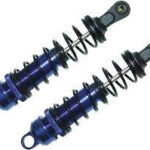Hydraulic shock absorbers are a great invention, but how do they work? A shock absorber is a device that is attached to a vehicle and gives it an extra cushion when it goes through a crash. There are two basic types of hydraulic shock absorbers: mono-tube and two-pipe. Mono-tube shock absorbers consist of one long tube with two separate chambers separated by a free-floating piston. Both are filled with oil or nitrogen gas. Mono-tube shock absorbers also have an additional component called a piston rod.
Regular shock absorbers work by adjusting to the road surface by letting the internal piston move more on a harder bump. The hydraulic oil causes this piston to encounter more resistance and a more rigid ride is a result. Some shocks can be adjusted manually for a firmer ride, while others automatically adapt to the road surface.
A hydraulic shock absorber basically consists of a cylinder filled with hydraulic oil and a piston. The piston slides up and down when the wheel moves. To operate, the spring compresses the piston, and the oil underneath the piston needs to flow through a narrow opening. Oil in the shock absorber can reach 120 degrees Celsius, and this heat is rapidly dissipated into the surrounding environment.
The simplest form of hydraulic shock absorbers is mono-tube. Mono-tube shock absorbers do not have an outer or reservoir tube, and adjust the amount of oil to suit the movement of the piston. A piston rod forces the oil to flow back through the piston. This resistance creates the shock and damping effect. This means that shock absorbers reduce maintenance and increase machine life. For advice on Hydraulic Power Pack units, visit https://www.hydraproducts.co.uk/
Hydraulic shock absorbers are considered one of the safest and most reliable forms of absorbing shocks. The Gabriel USA claims that their first hydraulic shock absorber was patented in 1907. They were soon made standard equipment in automobiles. This mechanism is available in a wide range of sizes and shapes, including traditional telescopic dampers. Shock absorbers have numerous fixings including bayonet mounts, ring mounts, and bar mounting fittings.
Hydraulic shock absorbers work by slowing the movement of suspension components by compressing and rebounding springs. They are velocity sensitive, meaning that the faster the springs move, the greater the resistance. This dampens the movement and prevents the vehicle from overbouncing. In addition, they keep the tyres in contact with the road. This prevents your car from rolling over uneven terrain. Once you know how they work, you’ll be able to appreciate the value of shock absorbers in your car.


